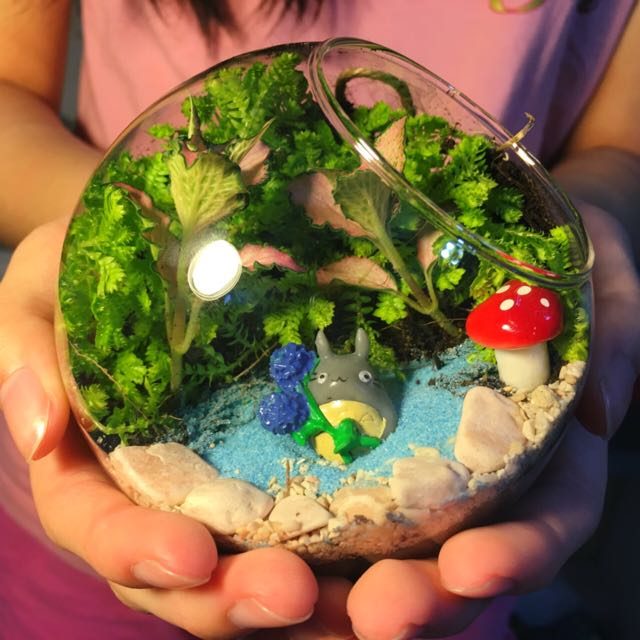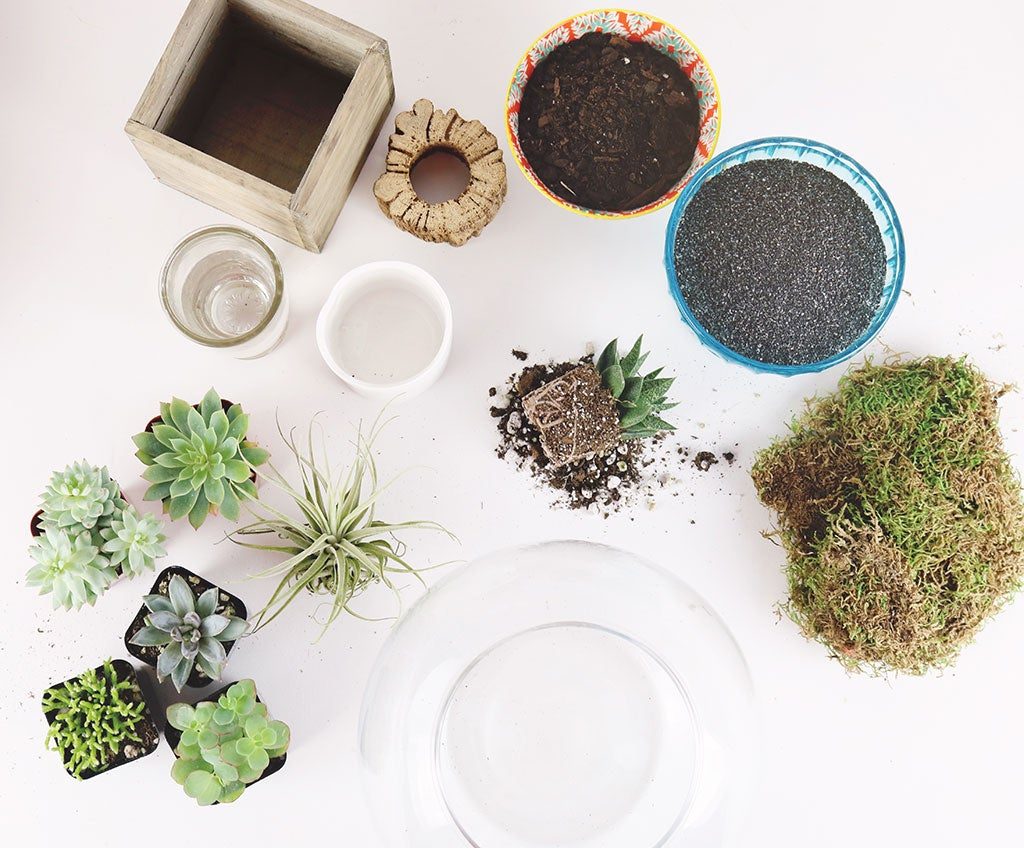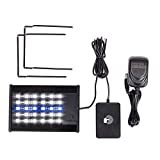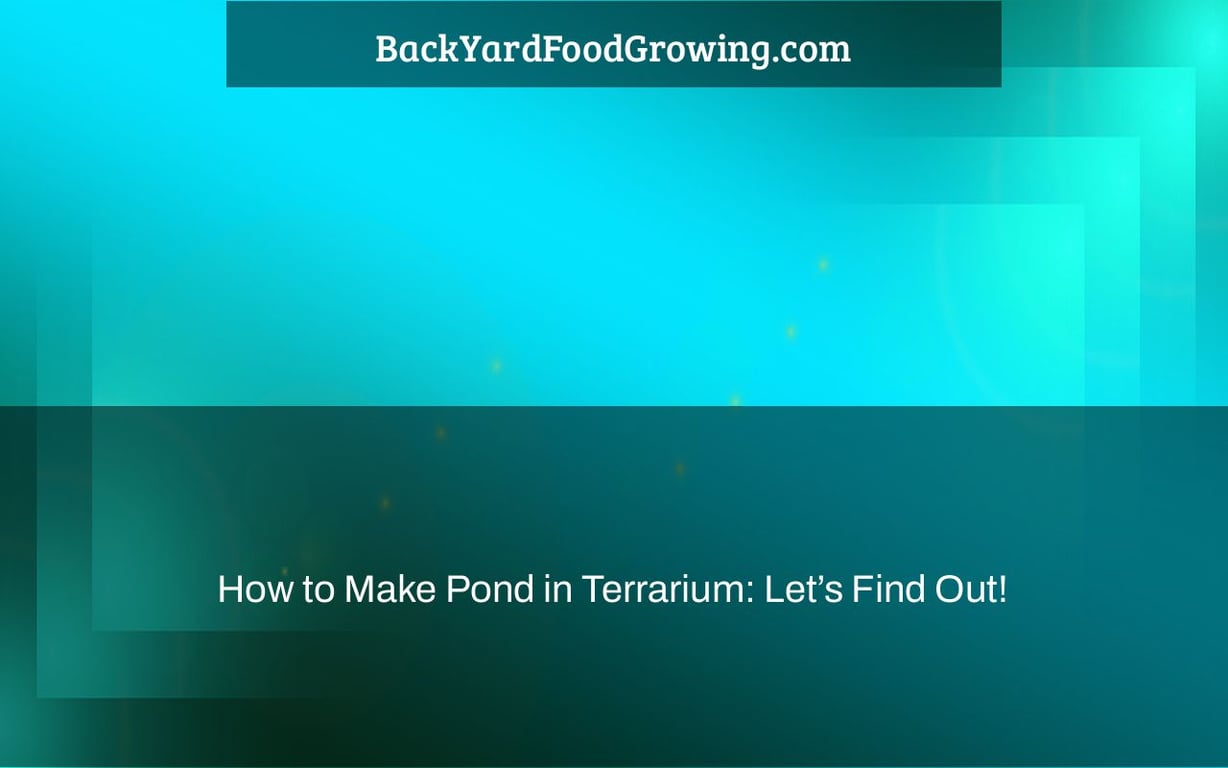Here is a video tutorial by the author on how to make an artificial pond in a terrarium. This project can be done with just five materials, and it will provide your terrarium with approximately 12 gallons of water for up to four months. It’s also possible that you might want to add some fish or frogs as well!
This is a pond that you can build for your terrarium. It will take about an hour to complete, and it’s easy to do!
Terrariums are among the most intricate ecosystems you can create. Making a pond in a terrarium, on the other hand, is one of the most difficult aspects of it.
Because the terrarium is a contained environment, creating and maintaining a pond might be difficult. So, we’re here to assist you figure out how to construct a terrarium pond?
A big enough tank is required to create a pond in a terrarium. Make drainage layers and divide the tank properly. After that, fill the container with water and a pump to keep it going. You’re fine to go as long as you take care of the lights and upkeep.
We appreciate that the whole procedure is a little difficult. There are several considerations that must be made. But don’t get worked up! We’ll be there to help you during the whole process.
So, let’s get this party started!
Is it Possible to Make a Pond in a Terrarium?

https://www.carousell.sg/p/ Source: https://www.carousell.sg/p/
Yes, to put it simply. In a terrarium, you may build a pond. Before you make a pond, you must first understand how a terrarium works.
A terrarium is essentially a miniature greenhouse. In a dry climate, it’s utilized to cultivate little plants. There are two sorts of terrariums: sealed terrariums and open terrariums. While sealed terrariums are used only for plants, open terrariums may also be used to house animals.
Open terrariums are often used for creatures such as lizards. As a result, you won’t be able to make a pond in such terrariums. A closed terrarium, on the other hand, is a self-contained system. It has its own water, lighting, and moisture cycles.
So, after your terrarium is up and going, you may add a pond!
What’s the Difference Between a Terrarium Pond and a Vivarium Pond?
Many people use the phrases terrarium and vivarium interchangeably. However, there are some distinctions between them that we often ignore.
The word “vivarium” is used to denote a variety of different enclosures. Aquariums, terrariums, mossariums, and other types of vivariums are all technically vivariums. However, there are a few distinctions between a Vivarium pond and a terrarium pond.
Vivariums are often bigger and come in a variety of styles. Depending on the kind of terrarium, they may contain fish, aquatic animals, terrestrial animals, and so forth.
As a result, the ponds in a vivarium are designed with these considerations in mind. The ponds in a terrarium, on the other hand, are created smaller depending on their intended use.
Step-by-step instructions for making a terrarium pond
Make sure your terrarium’s pond is self-sustaining before you start building it. So, how do you construct a self-contained terrarium?
To construct a self-sustaining terrarium, make sure all of the components are in working order. Only plants should be kept in the terrarium, which must be kept sealed. It should be a self-sustaining environment with healthy plants and natural elements.
Photosynthesis and respiration are two physiological systems that should operate together effortlessly. Also, make sure there’s a door where you can repair things if anything goes wrong!
With everything out of the way, let’s get started on constructing our own terrarium pond. Let’s get started!
Preparation
We must first prepare before we begin construction. The tank must be cleaned and prepped for use. To do so, we must first prepare. You must choose the appropriate container and prepare it properly.
Selecting a Container
So, what kind of container are you looking for? First and foremost, a pond cannot be created in a jar. As a result, leave them out of the calculation.
Terrariums may be made from of containers like fish tanks and aquariums. However, you must ensure that the glass is thinner than that used in standard aquariums. Furthermore, you must ensure that it is at least 5′ in length. You won’t be able to fit anything else if you don’t.
Getting the Container Ready
We need to prepare our container now that we’ve picked it. Both the interior and exterior of the container must be clean. Any residue or anything that may sit on it should also be avoided.
So, start Getting the Container Ready a few days before you start your terrarium. Make sure all the corners are thoroughly clean. Afterward, let it dry completely. I personally use some cleaners that are very best at removing hard and rough stains. Here’s a list of these cleaners for your convenience.
Dry it entirely and store it in a cool location. It’s ready to use after it’s thoroughly clean and dry!
Getting the Things You’ll Need

Source: https://blogs.afloral.com/
It’s time to get down to business with the technical things now that the container is ready. To set up a vivarium, you’ll need a few items. Keep them in your pocket and you’ll be OK.
If you have a canister filter, ensure sure it is primed as well at this step.
The following is a list of the supplies you’ll need for your terrarium pond kit:
Soil Preparation
The terrarium’s soil is crucial to its stability. You must ensure that the soil retains water while also supplying for the plants. As a result, you’ll need to adjust the soil mix properly.
There are three varieties of terrarium soil now: tropical, bog, and normal. You must organize and arrange your terrarium in accordance with the soil. You’ll need to build your soil mix based on the plants you wish to cultivate.
However, if you want to construct a pond-friendly soil mix, you’ll need to make some adjustments. It’s critical that your soil mix resists water while maintaining structural integrity. As a result, you must choose materials properly.
1 part Coco Fiber, 2 parts sphagnum moss, 1 part sand, 1 part potting mix, and 1 part active charcoal are the suggested sizes. Mix them together according to the size of your tank.
Move on to the following stages once the soil is ready!
Getting the Plants Ready
The plants are what make the terrarium worthwhile! As a result, you must carefully choose and maintain your plants!
Let’s have a look at what plants you may place in a terrarium now.
The plants you choose are determined by the sort of soil you have. Put the tropical plants in if you have tropical soil. Desert plants are the way to go if your soil is sandy. Make sure, however, that the root systems of your plants are compatible with the size of your terrarium.
To aid you in the process, here are some tropical and desert plant suggestions. Please have a look-
Make sure you’re selecting the right plants for your terrarium depending on your requirements. Also, make sure your plants’ roots are in excellent shape. To suit your system, certain plants may need to be rooted. As a result, double-check that.
Putting Together the Terrarium
After we’ve gathered all of our materials, we’ll begin building our enclosed terrarium with pond. You’re fine to go if you properly follow the guidelines.
Add Drainage Layers in Step 1
Making a drainage layer is the first and most crucial step. To ensure that everything else is functioning, start with the drainage layer.
Any water that passes through the substrate is caught by the drainage layer. As a result, any water saturation or waterlogging is avoided. When it comes to drainage, having additional layers is always a good idea.
If you’re wondering how to build the terrarium’s drainage layers, it’s easy-peasy.
As a foundation, put down a layer of something sturdy. It might be pebbles or rocks, for example. After that, add a layer of activated charcoal to function as a separator. The layer is complete and ready to use!
The following are the steps:
Fill the bottom with small stones or pebbles.
Place tiny stones or pebbles to begin your drainage layer. Check that the stones are of the same size and that the layer is even. The stone layer should be at least 1 inch thick. It’s important that the stones don’t take up too much room.
Activated Charcoal should be added.
We’ll put a lot of attention on drainage since we’ll be developing a pond in our terrarium. As a result, we propose combining the rocks with activated charcoal. Place a layer of activated charcoal on top of the rocks.
The point where the land joins the ocean should be highlighted. Make sure you have enough charcoal to prevent the layers from blending together.
Continue to the following stages once you’ve put the charcoal.
Step 2: Mix in the moss and soil.
The drainage layer and the substrate must now be kept separate. As a result, spread a layer of sphagnum moss around your tank.
Ensure that the moss has completely covered the pebbles and charcoal. This is the first stage in making a moss terrarium at home.
You may also use carbon fiber mesh instead of moss if you find it too difficult to deal with. After the moss has dried, add your soil mix and level it out. Your terrarium’s foundation is complete!
Step 3: Putting the Pond Together
Now it’s time to get the terrarium’s most difficult component, the pond, ready. Dealing with the pond might be difficult, so proceed with caution. For easier access, the pond should be in the middle.
To begin, remove dirt from the middle of the pond to create place for it. Make sure the moss and the charcoal layer aren’t being moved. Your pond is ready to be filled after the earth has been prepped.
Make sure the pond is linked to one end where the pump will be located.
Step 4: Fill the container with aquatic plants
It’s now time to arrange the plants in the container. As previously said, your terrarium needs adequate water to work correctly. As a result, be cautious with the plants.
Select plants that will thrive in your soil. Some plants will not grow well in your environment because of your root system. As a result, double-check if the roots are suitable with the plants you’ve chosen.
If you wish to add any decorations, now is the time to do so. Make sure you know how long driftwood takes to sink if you’re going to use it.
Putting the finishing touches on

https://www.homeandgardenextras.com/ Source: https://www.homeandgardenextras.com/
We’re nearly finished constructing our terrarium. With a little more work, we’ll be ready to travel! The last stages are as follows:
The first step is to set up a pump.
The first step in having a running terrarium is to set up a tank. To begin, make sure you have a reliable water pump and sufficient tubing. The steps for creating a pumping waterfall are as follows:
- Set up the back of the waterfall using corrugated plastic. Fold and cut plastic sheets to the waterfall’s desired size. Ensure that the pipes are hidden below the blankets.
- To let the water move through, cut small notches on the bottom of the plastic. Hot glue the whole thing together.
- I ended up using glue guns at this stage since I didn’t want to chance a sloppy bond. So far, the two glue guns I’ve had the most success with are the Gorilla Dual Temp Mini Hot Glue Gun and the Gorilla Dual Temp Mini Hot Glue Gun with 30 hot glue sticks. Also included with the Cobiz hot glue gun are ten excellent hot glue sticks.
- Make a pump enclosure out of plastic or foam. It may be hidden within the decorations or placed inside the pipes.
- Turn on the pump to test whether it’s operating when the adhesive has dried. If the pump is operational, you may go to the next stage!
Step 2: Pour in the water
It’s time to complete our terrarium with flowing water now that the pump is in place. Turn on the pump and fill the terrarium with water. It’s set if it’s running.
Provide a Light Source in Step 3
Your terrarium’s plants now need light to live. You won’t need any more sunlight if you can maintain it near the sun. If you want to preserve it without the sun, you’ll need to put lights on top of it.
Your terrarium will benefit greatly from a nice aquarium light. You’re OK to go as long as it has a day-night cycle. If you’re seeking for suggestions, the Kessil h80 is a good place to start. The light is evenly distributed and covers a 14-24′′ area. In the table below, I’ve drawn several additional high-range LED lights that I’ve tried and can recommend.
| Price | Image | Product | Advantage |
|---|---|---|---|
| Place your order right now! |  | Two A360X Tuna Blue LED Lights from Kessil | Comes with Controller & Two Goosenecks Package |
| Place your order right now! |  | Terrarium Light REPTI ZOO | When the power is turned off, it has a memory function. |
Is it Possible to Keep Fish in a Terrarium Pond?
In a nutshell, the answer is no! Fish cannot be kept in a terrarium. A terrarium is a plant-focused confined system. In addition, the terrarium’s material is often thinner than that of a tank. As a result, it is not conducive to fish growth.
Is a Terrarium Beneficial to Fish?
You can turn a terrarium into an aquarium if you already have one. However, your fish will not thrive in the existing terrarium. The substrate material, drainage, and other factors are insufficient for your fish.
So, if you’re thinking of getting a terrarium fish pond, we suggest starting from the beginning.
Do You Want to Put Other Animals in Your Terrarium Pond?
If you have a dry terrarium, it may be an excellent home for animals. Animals such as turtles and lizards thrive in the terrarium habitat. A terrarium filled with water, on the other hand, is not suited for animals.
A terrarium’s ecosystem, like that of fish, does not sustain other aquatic species. Keep this in mind when you create your terrarium.
Is it Possible to Include a Waterfall in a Terrarium Pond?
Yes! A waterfall may be added to a terrarium pond. You must have a functional pump as well as enclosures to keep the pump in place.
You may use a kit similar to the naturalistic terrarium waterfall kit if you want something basic. Don’t be concerned. We’ve compiled a list of the best kits on the market exclusively for you-
If you’re not sure how to utilize a kit, follow these steps:
- Remove the lid off a plastic container and cut holes in it. Make sure the opening is large enough for the waterfall hose to fit through.
- After that, insert the engine into the bowl and set it in the bottom.
- Select the waterfall intensity on the remorse and attach the tubes to the motor now that it’s set. Place the lid on the terrarium and close it.
- Place the hydro balls at the bottom of the tank after rinsing them in running water. Fill it all the way to the container’s rim.
- Cover the balls with a thin layer of netting and moss to hide them. You’re ready to go after you’ve completed your pond plant terrarium.
- After you’ve added water, turn it on.
The instructions for installing a waterfall kit in your terrarium waterfall pond are as follows.
Maintenance Instructions for Terrarium Ponds:
Now that we have our own terrarium, we must learn how to care for it. It might be difficult to keep a terrarium pond in good condition. However, learning how to care for your terrarium on a basic level may be really beneficial.
We now know how to make a terrarium pond. Let’s talk about how to care for our terrarium.
Getting Water Out
You need to first make sure you have no water in your terrarium. Once the water is gone, you can start fixing its problems. The steps to Getting Water Out are-
Step 1: Turn off all electrical outlets.
The first step is to ensure sure it’s not plugged into a power source. Remove all wires and disconnect the power supply from the central line. Begin the following steps when the connections have been disconnected.
Step 2: Take Away the Objects
Remove everything from your terrarium now. Begin with the plants and work your way up to any other decorations. Remove any animals you have in your terrarium as well.
3rd Step: Drainage
Now is the time to begin emptying our terrarium. The draining procedure includes the following steps:
Using a hose to siphon the water
You must get rid of any remaining water. The simplest method is to use a hose. Connect a hosepipe to the terrarium and drain as much water as possible. As a result, it’s critical to make it empty first.
Cleaning Gravel with a Gravel Cleaner
Water and moisture might now get trapped in your gravel. To do so, use a gravel cleaner like hygger Aquarium Gravel Cleaner to remove any moisture from the gravel. This cleaner is also great for cleaning the gravel of dirt and dust.
Plants that are dying or have become overgrown
It might be due to a variety of factors if your terrarium plants are dying. So, why are my terrarium plants dying, you may wonder?
Overwatering, selecting the incorrect container, combining the wrong plants, and insufficient lighting are all common causes of dying plants. You must determine the cause and address it.
Also, if you see withering plants, you may ponder whether or not you should remove the dead leaves from the terrarium.
Yes! Take out all of the dead plants and animals from the terrarium. It’s possible that the plants are infected. The illness will spread from one plant to another throughout the tank until it is eliminated.
You may also use Fertilizers to improve the health of your plants. The following are some nutrient-dense Fertilizers:
| Price | Image | Fertilizer | Usage |
|---|---|---|---|
| Place your order right now! |  | Indoor Plant Food Miracle-Gro (Liquid) | Edibles are included in all indoor houseplants. |
| Place your order right now! |  | All-Purpose Organic Complete Plant Food Liqui-Dirt Nano Powder | Indoor or outdoor use of a balanced blend of vitamins, minerals, microfungi, and bio-organisms |
However, make sure the fertilizer is safe for the other terrarium creatures and won’t cause them any problems.
FAQs
How do you create a terrarium water feature?
It all depends on what kind of feature you’re looking for. You can easily add ornaments, waterfalls, and other features to your terrarium. You may create your required features out of materials such as corrugated plastic.
What makes a vivarium different from a terrarium?
A vivarium is a word that refers to a variety of housings. Aquariums, terrariums, refugia, and other similar structures are examples. A terrarium is a dry, enclosed environment for plants and animals.
Is it better to keep terrariums open or closed?
It all depends on the terrarium you’re using. It must be open if you have a dry terrarium for animals. It must be closed for terrariums with water.
Final Thoughts
Making a pond in a terrarium might be difficult. It is, however, as simple as it gets given the correct resources and effort. We’ve gone through how to construct a pond in a terrarium in easy stages in this post. We hope you find this information helpful!
Have a wonderful day!
The “paludarium” is a type of terrarium that has a water feature. The word comes from the Latin words “palus” and “aqua”. This article will show you how to make one.
Related Tags
- how to make a terrarium
- pond wall substrate stop
- terrarium pond kit
- terrarium swimming pool
- josh’s frogs

